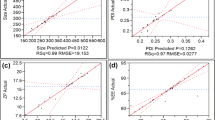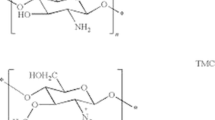Abstract
In recent years, natural polyelectrolyte complex chitosan/poly-γ-glutamic acid (CS/γ-PGA) has emerged as a promising nanocarrier delivery system for drug delivery due to its non-toxic and easily degradable properties. However, tightly bound CS/γ-PGA complexes often lead to lower encapsulation efficiency of peptide drugs without coordination of metal ions. In this investigation, we find that procyanidin (PC), as a cross-linking agent, is able to combine with CS and insulin through hydrogen bonding, which significantly improve encapsulation efficiency of insulin up to 90% in CS/γ-PGA/PC complex nanoparticles (CNPs). The results of this study demonstrate that CNPs release insulin in a pH-dependent approach and greatly reduce its enzymatic degradation in vitro. The transepithelial permeability of the CNPs is 8.1-fold higher than that of native insulin via both endocytosis and paracellular passways. Further pharmacokinetic studies reveal an oral pharmacological availability of 9.81 ± 1.32% in type I diabetic rats after intragastric administration of freeze-dried CNPs which loaded in enteric-coated capsules. In consequence, CNPs not only improve oral bioavailability of insulin but also are a promising delivery platform for insulin or other peptide/protein drugs.
Graphical Abstract







Similar content being viewed by others
Data availability
The data used to support the findings of this study are available from the corresponding author upon reasonable request.
References
Sun H, Saeedi P, Karuranga S, Pinkepank M, Ogurtsova K et al (2022) IDF Diabetes Atlas: Global, regional and country-level diabetes prevalence estimates for 2021 and projections for 2045. Diabetes Res Clin Pract 183:109–119
Steve C (2020) Rybelsus: an oral formulation of the GLP-1 agonist semaglutide. Prescriber 31(10):32–33
Zhao RC, Lu ZG, Yang J, Zhang LQ, Li Y et al (2020) Drug delivery system in the treatment of diabetes mellitus. Frontiers in bioengineering and biotechnology 8:880
Cho YM, Fujita Y, Kieffer TJ (2014) Glucagon-like peptide-1: glucose homeostasis and beyond. Annu Rev Physiol 76:535–559
Brown TD, Whitehead KA, Mitragotri S (2019) Materials for oral delivery of proteins and peptides. Nat Rev Mater 5(2):127–148
Khafagy ES, Morishita M (2012) Oral biodrug delivery using cell-penetrating peptide. Adv Drug Deliv Rev 64(6):531–539
Zhang X, Qi J, Lu Y, He W, Li X et al (2014) Biotinylated liposomes as potential carriers for the oral delivery of insulin. Nanomedicine 10(1):167–176
Martins JP, Auria RD, Liu D, Fontana F, Ferreira MPA et al (2018) Engineered multifunctional albumin-decorated porous silicon nanoparticles for FcRn translocation of insulin. Small 14(27):e1800462
Lin YH, Sonaje K, Lin KM, Juang JH, Mi FL et al (2008) Multi-ion-crosslinked nanoparticles with pH-responsive characteristics for oral delivery of protein drugs. J Control Release 132(2):141–149
Fan WW, Xia DG, Zhu QL, Li XY, He SF et al (2018) Functional nanoparticles exploit the bile acid pathway to overcome multiple barriers of the intestinal epithelium for oral insulin delivery. Biomaterials 151(1):13–23
Wang AH, Fan WW, Yang TT, He SF, Yang YW et al (2020) Liver-target and glucose-responsive polymersomes toward mimicking endogenous insulin secretion with improved hepatic glucose utilization. Adv Func Mater 30(13):1–15
Karamanidou T, Karidi K, Bourganis V, Kontonikola K, Kammona O et al (2015) Effective incorporation of insulin in mucus permeating self-nanoemulsifying drug delivery systems. Eur J Pharm Biopharm 97(Pt A):223–229
Ahmad N, Amin M, Ismail I, Buang F (2016) Enhancement of oral insulin bioavailability: in vitro and in vivo assessment of nanoporous stimuli-responsive hydrogel microparticles. Expert Opin Drug Deliv 13(5):621–632
Wang A, Yang T, Fan W, Yang Y, Zhu Q et al (2019) Protein corona liposomes achieve efficient oral insulin delivery by overcoming mucus and epithelial barriers. Adv Healthc Mater 8(12):e1801123
Zhou YH, Chen ZX, Zhao D, Li D, He CL et al (2021) A pH-triggered self-unpacking capsule containing zwitterionic hydrogel-coated MOF nanoparticles for efficient oral exendin-4 delivery. Adv Mater 33(32):e2102044
Sun LL, Liu ZJ, Tian HK, Le ZC, Liu LX et al (2018) Scalable manufacturing of enteric encapsulation systems for site-specific oral insulin delivery. Biomacromol 20(1):528–538
Hu QB, Luo YC (2018) Recent advances of polysaccharide-based nanoparticles for oral insulin delivery. Int J Biol Macromol 120(Pt A):775–782
Mansoor S, Kondiah PPD, Choonara YE, Pillay V (2019) Polymer-based nanoparticle strategies for insulin delivery. Polymers 11(9):1380
Zhao L, Skwarczynski M, Toth I (2019) Polyelectrolyte-based platforms for the delivery of peptides and proteins. ACS Biomater Sci Eng 5(10):4937–4950
Wang S, Zheng L, Chen W, Ji L, Zhang L et al (2021) Helically grooved gold nanoarrows: controlled fabrication, superhelix, and transcribed chiroptical switching. CCS Chemistry 3(9):2473–2484
Kim K, Kim K, Ryu JH, Lee E (2015) Chitosan-catechol: a polymer with long-lasting mucoadhesive properties. Biomaterials 52(1):161–170
Hsu LW, Ho YC, Chuang EY, Chen CT, Juang JH et al (2013) Effects of pH on molecular mechanisms of chitosan-integrin interactions and resulting tight-junction disruptions. Biomaterials 34(3):784–793
Lim YT, Shim SM, Noh YW, Lee KS, Choi DY et al (2011) Bioderived polyelectrolyte nanogels for robust antigen loading and vaccine adjuvant effects. Small 7(23):3281–3286
Lin YH, Mi FL, Chen CT, Chang WC, Peng SF et al (2007) Preparation and characterization of nanoparticles shelled with chitosan for oral insulin delivery. Biomacromol 8(1):146–152
Nguyen HN, Wey SP, Juang JH, Sonaje K, Ho YC et al (2011) The glucose-lowering potential of exendin-4 orally delivered via a pH-sensitive nanoparticle vehicle and effects on subsequent insulin secretion in vivo. Biomaterials 32(10):2673–2682
Santos-Buelga C, Scalbert A (2000) Proanthocyanidins and tannin-like compounds-nature, occurrence, dietary intake and effects on nutrition and health. J Sci Food Agric 80(7):1097–1117
Charlton AJ, Baxter NJ, Lilley TH, Haslam E, McDonald CJ et al (1996) Tannin interactions with a full-length human salivary proline-rich protein display a stronger affinity than with single proline-rich repeats. FEBS Lett 382(3):289–292
Luck G, Liao H, Murray NJ, Grimmer HR, Warminski EE et al (1994) Polyphenols, astringency and proline-rich proteins. Phytochemistry 37(2):357–371
Liu R, Wang LB, Huang RL, Su RX, Qi W et al (2013) Self-assembled oligomeric procyanidin-insulin hybrid nanoparticles: a novel strategy for controllable insulin delivery. Biomater Sci 1(8):834–841
Ji N, Hong Y, Gu ZB, Cheng L, Li ZF et al (2017) Binary and tertiary complex based on short-chain glucan and proanthocyanidins for oral insulin delivery. J Agric Food Chem 65(40):8866–8874
Liu R, Su RX, Liang M, Huang RL, Wang M et al (2012) Physicochemical strategies for inhibition of amyloid fibril formation: an overview of recent advances. Curr Med Chem 19(24):4157–4174
Sonaje K, Chen YJ, Chen HL, Wey SP, Juang JH et al (2010) Enteric-coated capsules filled with freeze-dried chitosan/poly(gamma-glutamic acid) nanoparticles for oral insulin delivery. Biomaterials 31(12):3384–3394
Hentz NG, Richardson JM, Sportsman JR, Daijo J, Sittampalam GS (1997) Synthesis and characterization of insulin-fluorescein derivatives for bioanalytical applications. Anal Chem 69(24):4994–5000
Ji N, Hong Y, Gu ZB, Cheng L, Li ZF et al (2019) Chitosan coating of zein-carboxymethylated short-chain amylose nanocomposites improves oral bioavailability of insulin in vitro and in vivo. J Control Release 313:1–13
Mukhopadhyay P, Sarkar K, Chakraborty M, Bhattacharya S, Mishra R et al (2013) Oral insulin delivery by self-assembled chitosan nanoparticles: in vitro and in vivo studies in diabetic animal model. Mater Sci Eng C Mater Biol Appl 33(1):376–382
Jing YJ, Huang JH, Yu XQ (2018) Preparation, characterization, and functional evaluation of proanthocyanidin-chitosan conjugate. Carbohyd Polym 194:139–145
Abuhelwa AY, Foster DJR, Upton RN (2016) A quantitative review and meta-models of the variability and factors affecting oral drug absorption-part I: gastrointestinal pH. AAPS J 18(5):1309–1321
Merchant HA, Afonso-Pereira F, Rabbie SC, Youssef SA, Basit A (2015) Gastrointestinal characterisation and drug solubility determination in animals. J Pharm Pharmacol 67(5):630–639
Su YR, Yu SH, Chao AC, Wu JY, Lin YF et al (2016) Preparation and properties of pH-responsive, self-assembled colloidal nanoparticles from guanidine-containing polypeptide and chitosan for antibiotic delivery. Colloids Surf, A 494:9–20
Roger N (2020) Oral delivery of biologics via the intestine. Pharmaceutics 13(1):e18
Rui G, Nuno M, Victor DF (2010) Biological relevance of the interaction between procyanidins and trypsin: a multitechnique approach. J Agric Food Chem 58(22):11924–11931
Acknowledgements
We are greatly appreciating the Scientific Research Foundation of Wuxi City for the Returned Overseas Chinese Scholars for supporting this research work.
Funding
Scientific Research Foundation of Wuxi City for the Returned Overseas Chinese Scholars
Author information
Authors and Affiliations
Corresponding authors
Ethics declarations
Conflict of interest
The authors declare no competing interests.
Additional information
Publisher's Note
Springer Nature remains neutral with regard to jurisdictional claims in published maps and institutional affiliations.
Contents
This work developed a novel CS/γ-PGA/PC complex nanoparticles (CNPs) for oral insulin delivery. Procyanidin (PC), as a cross-linking agent, was able to combine with CS as well as insulin through hydrogen bond which significantly improved encapsulation efficiency of insulin. The results of in vivo studies showed that freeze-dried CNPs, achieved 9.81 ± 1.32% of pharmacological availability after oral administration.
Rights and permissions
Springer Nature or its licensor (e.g. a society or other partner) holds exclusive rights to this article under a publishing agreement with the author(s) or other rightsholder(s); author self-archiving of the accepted manuscript version of this article is solely governed by the terms of such publishing agreement and applicable law.
About this article
Cite this article
Liu, K., Chen, Y., Yang, Z. et al. Preparation and characterization of CS/γ-PGA/PC complex nanoparticles for insulin oral delivery. Colloid Polym Sci 301, 481–490 (2023). https://doi.org/10.1007/s00396-023-05078-1
Received:
Revised:
Accepted:
Published:
Issue Date:
DOI: https://doi.org/10.1007/s00396-023-05078-1




